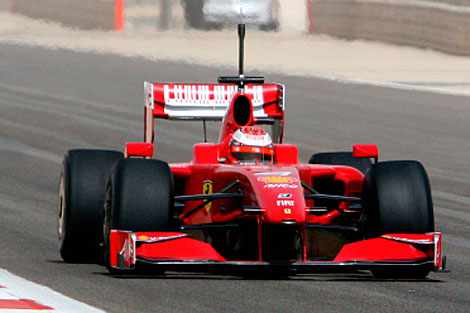
With only 6-weeks until the start of the 2009 Formula 1 season, teams are actively testing their new machines in preparation for the first race in Melbourne, Australia. This season Formula 1 teams will not be permitted to test once the season begins, with the exception of practice day on the Friday of race weekends. This, combined with the large scale changes in technical regulations for this season , puts added pressure on the engineers and designers to develop and prove their technology.
Test times are of little value to we fans, only the teams know what they represent as they run test programmes with different fuel loads and experiment with components that may or may not be used on the final race car. They are an indication of how close the competition may be however, and if last weeks times are any indication of this, we will have a much smaller spread in the field this season.
The major performance change for 2009 is the re-introduction of slick tires and the new aerodynamic regulations. Slick tires will provide 20% more mechanical grip than the grooved tires and the new aero package will reduce down-force by an estimated 50%. This means that the cars will be faster in slow-speed corners where the wings don’t have the airflow to work and slower in the high-speed corners, where the down-force will be reduced, compared to the 2008 cars. Initial test times indicate the new cars are about 3-seconds per lap slower at this stage in their development. That, of course, will change as development advances.
The prime challenge for all of the teams will be to learn how the new slick tires perform. This is critical to how they set the balance of the car and how long they can race between pit-stops. Formula 1 cars rarely fill the fuel tank, instead, they plan fuel stops to optimize their average lap times in concert with tire wear. As the tire wears the grip characteristics change, and so will the balance of the car because the front and rear tires may wear at different rates. (This will change from circuit to circuit). It is critical that the teams understand the wear pattern for the new slick tires in order to plan their strategy for the first race.
McLaren is an ideal example, they chose to test with the 2008 spec rear wing last week, simulating 2008 rear down-force. This is a wise move as it will provide an accurate comparison between the new tire and the old. They have several rear wing designs on the table (OK computer) and, based on their findings last week, will develop and test the designs they feel will be most beneficial in practical application.

All of the teams report a change in overall balance between the 2008 and 2009 cars. This is due to the increase in front down-force and the reduction of rear down-force in the new designs. One positive note, for Ferrari fans, is Kimi Raikkonen’s initial pleasure with the new Ferrari F60. Kimi struggled to find a set-up that suited his driving style last season. He seemed very comfortable with his new car. Kimi might just prefer a “tail happy” car (more front grip than rear).
Most of the teams tested with KERS last week and few problems were reported. This does not indicate they are happy with their systems, just that they are not saying much. It is rumoured that the major manufacturer backed teams Ferrari (Fiat), McLaren (Mercedes), BMW, Toyota and Renault will start the season with KERS installed. Williams, who are taking a different route by using a spinning flywheel system, have announced they will introduce KERS for the 7th race in Turkey.
Due to sandstorms that closed the Sakhir circuit in Bahrain last week, testing here will continue this week for Ferrari, Toyota and BMW. There are three more test sessions planned before the start of the season. Don’t pay too much attention to lap times just yet, most teams are working on race-length simulations to test reliability and tire wear. Soon they will all begin to test in qualifying trim, only then will individual lap times become more significant.
The new regulations have produced some interesting differences in the appearance of the various 2009 contenders. This may change as testing progresses though, I doubt we will have 18 clone-like cars on the grid for Melbourne. It promised to be an interesting season for Formula 1 fans.

